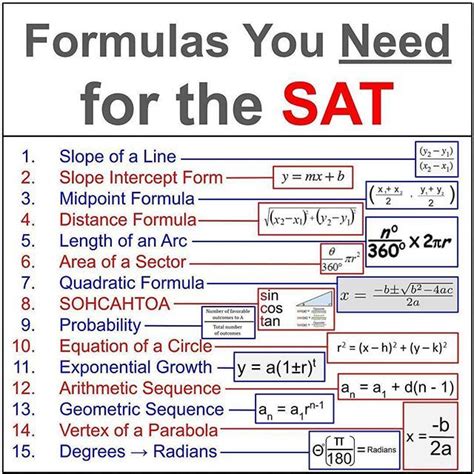Mastering the SAT Math section requires a solid foundation in mathematical concepts and formulas. Equipping yourself with a comprehensive formula sheet is crucial for success on test day. This guide provides you with the essential formulas you must know to conquer the challenging questions on the SAT.

Key Statistics for the SAT Math Section
- Percentage of Total Score: 50%
- Number of Questions: 58 (No Calculator) / 38 (Calculator)
- Average Score Range: 510-560
Algebra
Linear Equations:
– Slope-intercept form: y = mx + b
– Point-slope form: y – y1 = m(x – x1)
Quadratic Equations:
– Standard form: ax² + bx + c = 0
– Factoring: (ax + b)(cx + d) = 0
– Quadratic formula: x = (-b ± √(b² – 4ac)) / 2a
Inequalities:
– Linear inequalities: ax + b > c
– Quadratic inequalities: ax² + bx + c > 0
Functions:
– Linear functions: y = mx + b
– Quadratic functions: y = ax² + bx + c
– Exponential functions: y = a^x
– Logarithmic functions: logₐ(x) = y
Geometry
Pythagorean Theorem:
– a² + b² = c²
Area of Common Shapes:
– Rectangle: A = lw
– Triangle: A = ½bh
– Circle: A = πr²
Perimeter of Common Shapes:
– Rectangle: P = 2l + 2w
– Triangle: P = a + b + c
– Circle: P = 2πr
Volume of Common Solids:
– Rectangular prism: V = lwh
– Cylinder: V = πr²h
– Sphere: V = (4/3)πr³
Trigonometry
Trigonometric Ratios:
– Sine: sin(θ) = opposite / hypotenuse
– Cosine: cos(θ) = adjacent / hypotenuse
– Tangent: tan(θ) = opposite / adjacent
Trigonometric Identities:
– sin²(θ) + cos²(θ) = 1
– tan²(θ) + 1 = sec²(θ)
Statistics
Mean:
– x̄ = (Σx) / n
Standard Deviation:
– σ = √(Σ(x – x̄)²) / (n – 1))
Probability:
– Independent events: P(A and B) = P(A) × P(B)
– Dependent events: P(A and B) = P(A) × P(B|A)
Additional Tips
- Familiarize yourself thoroughly with the formulas.
- Practice applying the formulas to solve problems.
- Utilize the formula sheet on test day, but don’t rely on it heavily.
- Understand the concepts behind the formulas.
Table 1: Frequently Tested Algebra Formulas
| Formula | Application |
|---|---|
| Slope-intercept form | Finding the equation of a line |
| Quadratic formula | Solving quadratic equations |
| Linear inequality | Graphing inequalities |
| Exponential function | Modeling exponential growth or decay |
| Logarithmic function | Solving equations involving exponents |
Table 2: Essential Geometry Formulas
| Formula | Application |
|---|---|
| Pythagorean theorem | Solving right triangles |
| Area of a circle | Finding the area of circles |
| Volume of a sphere | Calculating the volume of spheres |
| Trigonometric ratios | Solving trigonometric equations |
| Trigonometric identity | Proving trigonometric relationships |
Table 3: Key Statistics Formulas
| Formula | Application |
|---|---|
| Mean | Finding the average of a data set |
| Standard deviation | Measuring the spread of a data set |
| Probability | Calculating the likelihood of events |
| Independent events | Combining probabilities of independent events |
| Dependent events | Combining probabilities of dependent events |
Table 4: Recommended Study Strategy
| Phase | Duration | Focus |
|---|---|---|
| Familiarization | 1-2 weeks | Read and understand the formulas |
| Practice | 2-4 weeks | Apply formulas to solve problems |
| Review | 1-2 days before test | Review formulas and practice problems |
Conclusion
Mastering the formula sheet is essential for maximizing your score on the SAT Math section. Dedicate the necessary time to study and practice these formulas. Remember to not only memorize them but to also understand their applications. This guide provides you with the resources and knowledge you need to feel confident and prepared on test day.
